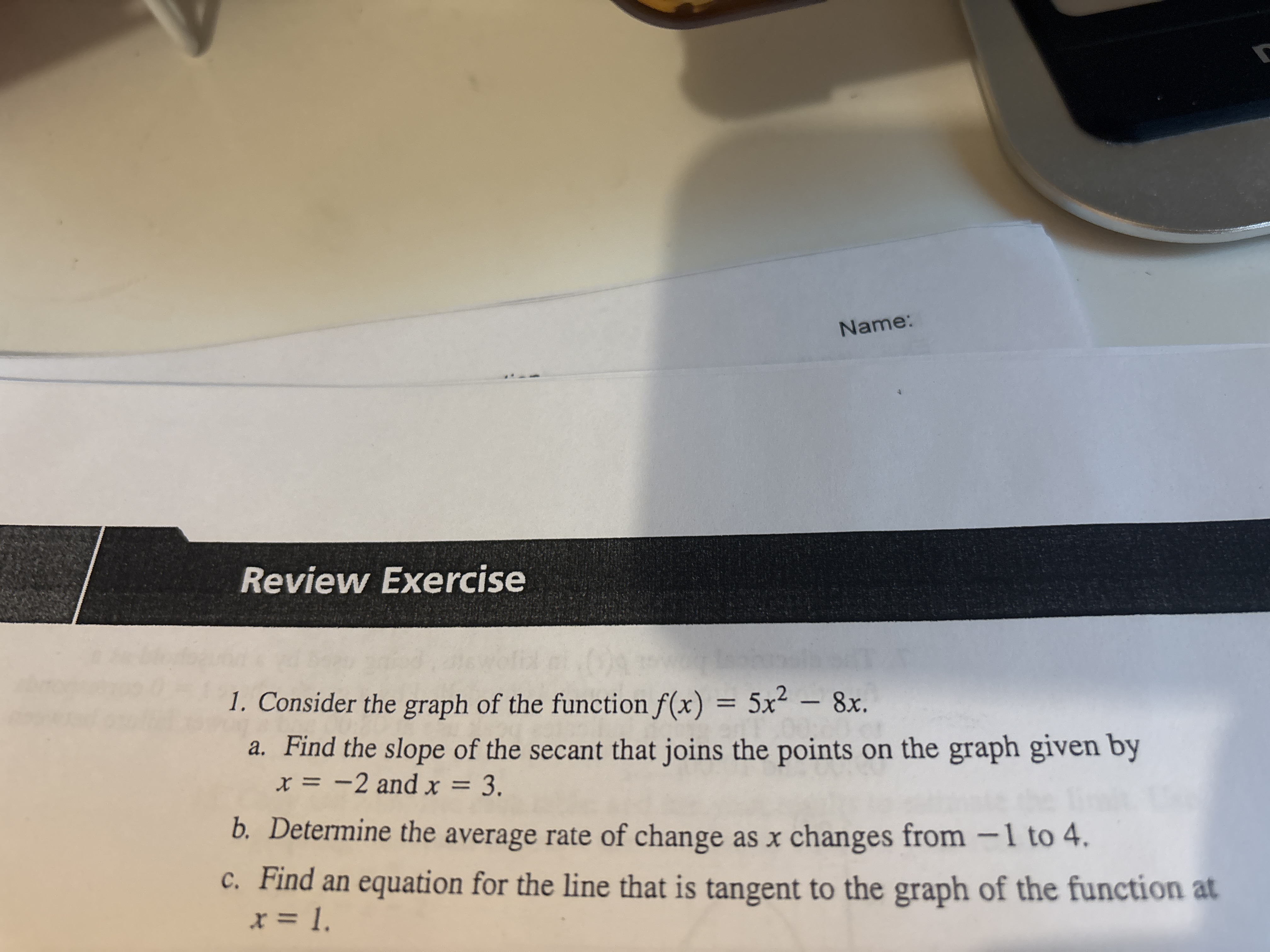Consider the graph of the function f(x) = 5x^2 - 8x. a. Find the slope of the secant that joins the points on the graph given by x = -2 and x = 3. b. Determine the average rate of... Consider the graph of the function f(x) = 5x^2 - 8x. a. Find the slope of the secant that joins the points on the graph given by x = -2 and x = 3. b. Determine the average rate of change as x changes from -1 to 4. c. Find an equation for the line that is tangent to the graph of the function at x = 1.

Understand the Problem
The question is asking you to analyze the graph of the function (f(x) = 5x^2 - 8x). Specifically, you need to: a) Find the slope of the secant line connecting the points on the graph where (x = -2) and (x = 3). b) Determine the average rate of change of the function as (x) varies from -1 to 4. c) Find the equation of the tangent line to the graph of the function at (x = 1).
Answer
a. $-3$ b. $7$ c. $y = 2x - 5$
Answer for screen readers
a. The slope of the secant line is $-3$. b. The average rate of change is $7$. c. The equation of the tangent line is $y = 2x - 5$.
Steps to Solve
- Find the y-coordinates for x = -2 and x = 3 for part a
Substitute $x = -2$ and $x = 3$ into the function $f(x) = 5x^2 - 8x$:
For $x = -2$: $f(-2) = 5(-2)^2 - 8(-2) = 5(4) + 16 = 20 + 16 = 36$
For $x = 3$: $f(3) = 5(3)^2 - 8(3) = 5(9) - 24 = 45 - 24 = 21$
So the points are $(-2, 36)$ and $(3, 21)$.
- Calculate the slope of the secant line for part a
The slope of the secant line is given by the formula: $m = \frac{y_2 - y_1}{x_2 - x_1}$ Using the points $(-2, 36)$ and $(3, 21)$: $m = \frac{21 - 36}{3 - (-2)} = \frac{-15}{5} = -3$
- Find the y-coordinates for x = -1 and x = 4 for part b
Substitute $x = -1$ and $x = 4$ into the function $f(x) = 5x^2 - 8x$:
For $x = -1$: $f(-1) = 5(-1)^2 - 8(-1) = 5(1) + 8 = 5 + 8 = 13$
For $x = 4$: $f(4) = 5(4)^2 - 8(4) = 5(16) - 32 = 80 - 32 = 48$
So the points are $(-1, 13)$ and $(4, 48)$.
- Calculate the average rate of change for part b
The average rate of change is the slope of the secant line between the points $(-1, 13)$ and $(4, 48)$.
$m = \frac{48 - 13}{4 - (-1)} = \frac{35}{5} = 7$
- Find the derivative of f(x) for part c
To find the tangent line, we first need the derivative of $f(x) = 5x^2 - 8x$. Using the power rule: $f'(x) = 10x - 8$
- Find the slope of the tangent line at x = 1 for part c
Evaluate the derivative at $x = 1$: $f'(1) = 10(1) - 8 = 10 - 8 = 2$
So the slope of the tangent line at $x = 1$ is $2$.
- Find the y-coordinate at x = 1 for part c
Evaluate the original function at $x = 1$: $f(1) = 5(1)^2 - 8(1) = 5 - 8 = -3$
The point on the graph is $(1, -3)$.
- Find the equation of the tangent line for part c
Using the point-slope form of a line: $y - y_1 = m(x - x_1)$, where $m = 2$ and the point is $(1, -3)$.
$y - (-3) = 2(x - 1)$ $y + 3 = 2x - 2$ $y = 2x - 5$
a. The slope of the secant line is $-3$. b. The average rate of change is $7$. c. The equation of the tangent line is $y = 2x - 5$.
More Information
The secant line represents the average rate of change of a function between two points, while the tangent line represents the instantaneous rate of change at a single point. The derivative of the function gives the slope of the tangent line at any point.
Tips
- Incorrectly calculating the function values at given x-values.
- Making errors when calculating the slope.
- Not finding the derivative correctly.
- Using the incorrect formula for the tangent line.
AI-generated content may contain errors. Please verify critical information